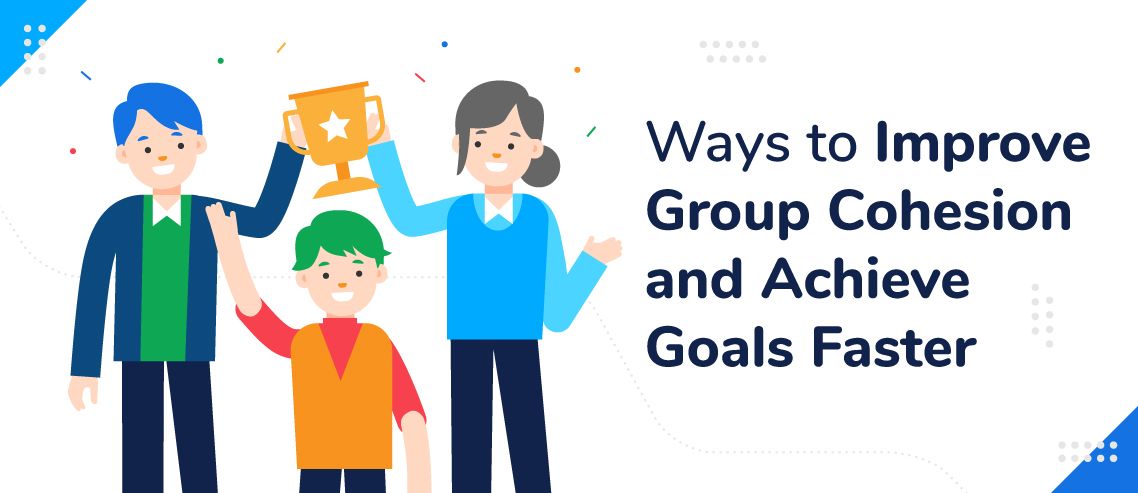7 Ways to Improve Group Cohesion and Achieve Goals Faster

As humans, we’re wired to want more. We want to be more, earn more, and achieve more.
An equally strong desire is fitting in, feeling like we belong to a group, or as Seth Godin calls it, a tribe.
These innate feelings bring us together and allow us to achieve great things. When they’re out of sync, we’re doomed for failure. If groups don’t trust each other, lack proper direction, or lose sight of their shared objectives, they’ll face setback after setback.
So how can you fast track group cohesion?
It starts with great leadership. The kind of authority and influence that builds great teams knows there are a few critical tactics anyone can implement to produce greater results, faster.
Here are seven ways you can do the same:
1. Stick With Smaller Groups
Bigger is not always better. In fact, adding more team members can be counterproductive
Psychologist and Management Professor, Jennifer Mueller, called this phenomenon “relational loss” in her study titled “Why Individuals in Larger Teams Perform Worse.” Relational loss happens when “an employee perceives that support is less available in the team as team size increases.” A perceived loss of support comes from both management and teammates. As group sizes rise, it’s more difficult for managers to offer individual attention.
Another great example of this is Amazon CEO Jeff Bezos’s famous “two pizza rule,” which states that if a team can’t be fed by two pizzas, then that team is too big.
2. Encourage Personal Interactions
We all need friends at work. Allies keep things interesting, provide an outlet to vent, and help us tackle our day-to-day obstacles.
When putting together an elite team for a special project, it’s imperative that you facilitate some team bonding. People are more alike than different, and the difference between being strangers and pals is finding commonality.
Building camaraderie is sometimes as simple as socializing over a meal or doing a group activity together. Encourage group members to get together outside of work hours, and when at work, try incorporating some icebreaker games.

3. Provide Feedback & Ongoing Training
Teams are only as strong as their weakest link, so it’s imperative to thread performance evaluations into the fold at regular intervals. This is especially important if you’re looking to improve group cohesion and achieve goals more quickly.
The biggest payoff comes from ongoing one-on-ones between managers and individual contributors. Scheduling time to go over performance, provide feedback, and overcome obstacles is critical in the early stages of the project. Done correctly, this will set the tone for the project and maintain high expectations from the get-go.
One-on-one meetings can be loose and unstructured, or they can also be highly detailed, like with Individual Development Plans (IDP) that provide ongoing employee feedback designed to help employees grow.
4. Set Goals With Clear Deadlines
From the beginning, each individual and each team should have clear goals. Without them, competition and conflict will demolish any team cohesion you’ve worked tirelessly to create. If possible, get them involved in the brainstorming and goal-setting process early. Nothing provides ownership, like asking people for advice and letting them run with their own ideas.
Once goals are set, you should set your eyes on creating precise milestones and deadlines. American composer, Duke Ellington famously said, “I don’t need time. What I need is a deadline.” Nothing motivates teams to harness every ounce of energy and resolve they have like a deadline.
5. Maximize Your Team’s Ability to Focus
With a finite amount of hours in the day, it’s crucial that your team is using them effectively.
Having too many priorities is the same as having none, and fewer goals mean fewer distractions and an increased probability of success.
Get in the habit of regularly reviewing your team’s calendar and goals to remove anything from their plate that may be distracting. Consider removing individuals if they aren’t pulling their weight as well.

6. Create Contingency Plans
It’s always good to spend time reflecting on what success looks like for your project. Anything you can do to remove barriers and make your group work together more effectively will pay dividends toward achieving goals faster.
What’s equally important is reflecting on what failure looks for your project. That way, you can prepare in advance for any potential risks that may arise. An excellent technique for this is called the inversion technique.
This means reflecting on what the opposite of success looks like and doing the inverse. For example, if your goal is to make your company more innovative, you’d spend time answering a question like “What would we need to do to make this company less innovative?” Whatever you come up with is what you know not to do.
7. Celebrate Success
Not celebrating wins holds your company back. No matter what your team does, big or small, take time to celebrate the victories. Recognize their achievements throughout the project as they complete vital milestones. Plan for a big celebration or reward of some kind when the project is 100% complete.
A little appreciation goes a long way to boosting morale, keeping the team engaged, and building camaraderie. Building that team cohesion is an ongoing process and the more you celebrate their success, the tighter their bond will become.
How do you boost group cohesion? We’d love to hear your tips in the comments below:
JD enjoys teaching people how to use ZoomShift to save time spent on scheduling. He’s curious, likes learning new things everyday and playing the guitar (although it’s a work in progress).



